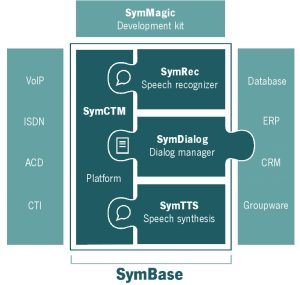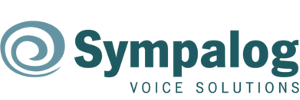SymBase5: Speech Platform

The platform SymBase5 is a further development of the speech platform SymBase. The newly configured dialog manager offers adjusted interfaces in order to integrate internet applications as well as speech. The focus is on mobile devices such as iPhone or Android apps.
SymBase5 allows for an easy integration of mobile applications into already existing processes and systems. The interfaces to corporate data remain unchanged and the legitimation and validation of input can be transferred as well.
As a speech platform, SymBase5 forms the perfect automated interface between telephony and electronically stored data. Speech dialog systems based on SymBase5 can answer or pre-qualify calls automatically thus lessening the burden on call center agents substantially. SymBase5 offers maximum convenience thanks to state of the art technology: The caller can speak naturally, interrupt, correct or change the subject and thus request the desired information or initiate transactions.
Benefits from using the speech platform SymBase5
Apart from a highly improved customer service due to permanent availability and no waiting times while maintaining a high degree of user-friendliness, SymBase5 offers the following benefits:
- Easy integration into existing telecommunications structures via standard protocols
- Cost savings thanks to optimized use of human resources
- Broader customer base owing to the creation of new services or new access channels
The modular structure of SymBase5

SymPBX establishes the connection to the telephone system and coordinates the communication between speech recognition, dialog manager and synthesis.
Recognition engines are integrated using standardized interfaces. Besides the Sympalog speech recognizer SymRec, other commercial products can be used.
SymDialog, the dialog manager, is the “intelligence” behind the system; it analyzes voice data input and generates a dynamic system response.
SymTTS, the text-to-speech module, is responsible of converting the text-based system response into a voice signal using pre-recorded speech or third-party TTS components.
Within the framework of SymBase5, the single components can be operated distributedly across a network. Open interfaces allow connections to existing databases. The integrated logging and reporting generates all the data pertaining to the dialog process that can be used for statistical evaluations.
Areas of application – general purpose and multi-class system
The speech platform SymBase5 is not restricted to specific business sectors or applications. On the contrary, thanks to the dynamic interaction and the uncomplicated application generation, user-friendly systems for any area of application can be implemented and expanded quickly:
- Fully automatic information and transaction systems, e.g. for the (electric) power industry, banks/insurances, service providers, retail, leisure or industry
- Efficient pre-qualification and routing of the callers
- Automated switching on the basis of specific criteria such as a name, a department, a problem or a subject matter
- Data acquisition for quality assurance, logistics and helpdesks
All the applications can also be a part of a more complex contact center solution.
Speech Platform
- Compatible with standard PC hardware
- Operating systems: Linux, Windows (Vista/XP/etc.), Windows Server; other Unix versions on request
- Flexible scalability (S0 or S2M) via CAPI interface or VoIP (H.323, SIP)
- Call forwarding and routing
- Automatic fax recognition and re-routing
- DTMF recognition
- Remote maintenance
- Voice recording
- Integrated speech recognizers: SymRec, EML; others on request
- Integrated TTS modules: SymTTS, Acapela; others on request
Dialog
- Mixed-initiative dialogs: callers can speak freely
- Dynamic dialog management depending on database content
- Flexible escalation stages in case of understanding problems
- Meta utterances (“Help!”, “Can i change the date, please?”)
- Processing of Out-Of-Focus responses
- Context-dependent help
- Extracting multiple informations from one response is possible
- Freely configurable confirmation strategy
- Configurable dialog memory
- speaker adaption
- Processing of prosodic information
Logging/Reporting
- All relevant data is stored in a mySQL database
Interfaces
- ERP systems (SAP, etc.), databases (Microsoft SQL Server, mySQL), web services; others on request
- Telephony: ISDN (e.g. EDSS1, QSIG over CAPI 2.0), VoIP (SIP, H.323)
- Mobile applications: TCP/IP or HTTP, communication via XML and JSON, HTML
